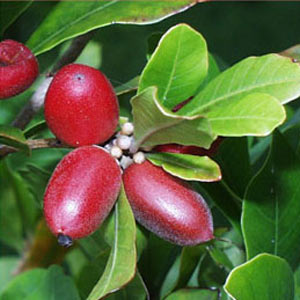|
Miracle Berry’s Mystery Cracked
Researchers in Japan Developing a Safe Sweetener for Anti-Diabetes and Anti-Obesity Use
by Fabian Perez, age 14

Scientists
have recently uncovered the secrets of the red miracle berry, this
berry tricks your taste buds, coating your tongue with a juice that
makes sour foods, like vinegar and lemon, taste super sweet. For four
decades, why this type of berry changes sour flavors to sweet has been a
mystery. Researchers at the University of Tokyo have discovered the
miracle berry’s secrets.
This particular berry comes
from a plant called Richardella dolcifica, which grows in West Africa.
In order to understand the mystery behind the miracle berries,
scientists used a type of cultured cells to imitate real human taste
cells. They discovered that miraculin strongly binds to sweet taste
buds. The protein changes shape in the presence of the acid in the human
mouth. This combination activates the sweet taste buds, creating a
sensation of ultra-sweet flavor, which drowns out the sour.
When
you swallow the sour, acidic food, the miraculin goes back to its
previous inactive shape. It remains there in the sweet receptor for an
hour or so, waiting for the next acidic treat.
The
red miracle berry also affects the taste of sweet foods in many
interesting ways. If you put a lot of aspartame (artificial sugar) on
your tongue after eating a miracle berry, the miraculin will repress
your sweet receptors. This will make sweet foods taste bland. But in
more acidic conditions, the berry makes aspartame taste really sweet.
In Japan the miracle berry is very popular among dieters.
According to lead researcher, Keiko Abe, “We are interested in a
large-scale production of miraculin because it has a good, sucrose-like
taste and combines a non-caloric property, since developing a safe
sweetener for anti-diabetes and anti-obesity uses is of pressing
importance.”
In the U.S., the FDA has decided that the miracle
berry is an unhealthy additive, and still needs to be properly tested.
It is not being produced commercially.
[Source: http://www.wired.com]
|

